


xxxxxThe German brothers Jakob and Wilhelm Grimm are remembered today for their fairy tales, contained in their two volumes of Nursery and Household Tales, published in 1812 and 1815. They collected these stories over a number of years, mainly from relatives, friends and village folk. Amongst the 210 stories collected were Hansel and Gretel, Sleeping Beauty, and Snow White and the Seven Dwarfs. These tales inspired a number of opera composers, including Engelbert Humperdinck and Sergei Prokofiev. Both brothers were interested in the development of the German language and German literature, and both worked on producing the first volumes of a monumental German Dictionary.
THE GRIMM BROTHERS
Jakob 1785-
Wilhelm 1786-
Acknowledgements
Grimm Brothers: by the Polish-
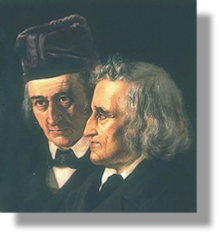 xxxxxIt was in 1812 that the German brothers Jacob and Wilhelm Grimm published their first collection of Nursery and Household Tales. A second volume appeared in 1815 and, after revision and additions, the final collection contained a total of 210 stories. They were translated into some seventy languages and, in the English version, were published under the title of Grimm’s Fairy Tales. Both brothers were enthusiastic collectors of these timeless stories. They were mostly obtained from relatives, friends and village folk, and included popular tales like Hansel and Gretel, Tom Thumb, Snow White and the Seven Dwarfs and Rumpelstiltskin (illustrated below). Most of these had a lesson to tell about the dangers of life, and many made good use of witches, goblins and trolls to get their message across!
xxxxxIt was in 1812 that the German brothers Jacob and Wilhelm Grimm published their first collection of Nursery and Household Tales. A second volume appeared in 1815 and, after revision and additions, the final collection contained a total of 210 stories. They were translated into some seventy languages and, in the English version, were published under the title of Grimm’s Fairy Tales. Both brothers were enthusiastic collectors of these timeless stories. They were mostly obtained from relatives, friends and village folk, and included popular tales like Hansel and Gretel, Tom Thumb, Snow White and the Seven Dwarfs and Rumpelstiltskin (illustrated below). Most of these had a lesson to tell about the dangers of life, and many made good use of witches, goblins and trolls to get their message across!
xxxxxBut both brothers were also talented in other directions. Whilst Wilhelm, the more literary of the two, played the major part in compiling the fairy stories, he also produced Old Danish Hero Songs, a treatise on German Heroic Legends, The Song of Roland, and a work on Old German Speech. Jacob, on the other hand, was the greater scholar, and was particularly interested in the structure of language. With the help of Wilhelm he began compiling a standard German Dictionary, a work which became a model for dictionaries in many other languages. Such was the scope and thoroughness of this 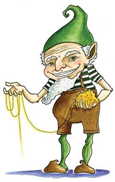 monumental task that the first volume was not published until 1852, and the work as a whole was not completed until 1860. Furthermore, in 1822, as professor of philology at Göttingen, Jacob formulated what came to be known as Grimm’s Law -
monumental task that the first volume was not published until 1852, and the work as a whole was not completed until 1860. Furthermore, in 1822, as professor of philology at Göttingen, Jacob formulated what came to be known as Grimm’s Law -
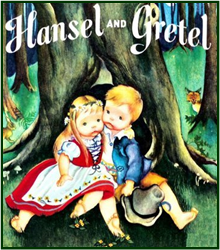 xxxxxThe Grimms were born in Hanau, central Germany, and were educated at the University of Marburg. Although Jacob remained a bachelor, and Wilhelm married and had three children, they lived and worked together for most of their lives. They found employment in Kassel for a time. They worked in the Elector’s library for the most part, but Jacob also worked as a secretary in the diplomatic service and, as such, attended the Congress of Vienna in 1815. Then in 1830 they obtained positions at the University of Gottingen, Wilhelm as a librarian and Jacob lecturing in philology. They were eventually appointed teachers at the Prussian Academy of Sciences in Berlin, and it was here that they spent the remainder of their lives.
xxxxxThe Grimms were born in Hanau, central Germany, and were educated at the University of Marburg. Although Jacob remained a bachelor, and Wilhelm married and had three children, they lived and worked together for most of their lives. They found employment in Kassel for a time. They worked in the Elector’s library for the most part, but Jacob also worked as a secretary in the diplomatic service and, as such, attended the Congress of Vienna in 1815. Then in 1830 they obtained positions at the University of Gottingen, Wilhelm as a librarian and Jacob lecturing in philology. They were eventually appointed teachers at the Prussian Academy of Sciences in Berlin, and it was here that they spent the remainder of their lives.
xxxxxIncidentally, the German romantic painter Philipp Otto Runge (1777-
Including:
Ernst Theodor Amadeus Hoffmann,
Adam Gottlob Oehlenschlager
and Heinrich von Kleist

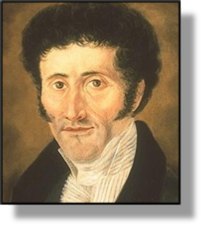 xxxxxIt was in 1816 that the German writer and composer Ernst Theodor Amadeus Hoffmann (1776-
xxxxxIt was in 1816 that the German writer and composer Ernst Theodor Amadeus Hoffmann (1776-
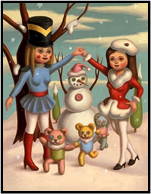 xxxxxAmong his famous works are The Golden Pot, Nutcracker and the novel The Devil’s Elixir. These and other stories inspired a number of musical compositions. These include The Mastersingers of Nurnberg by the German composer Richard Wagner in 1868, the ballet Coppélia of 1870 by the French composer Léo Delibes, Tales of Hoffmann, by the French composer Jacques Offenbach, first performed in 1881, and The Nutcracker, a ballet suite by the Russian composer Pyotr Tchaikovsky, produced in 1892.
xxxxxAmong his famous works are The Golden Pot, Nutcracker and the novel The Devil’s Elixir. These and other stories inspired a number of musical compositions. These include The Mastersingers of Nurnberg by the German composer Richard Wagner in 1868, the ballet Coppélia of 1870 by the French composer Léo Delibes, Tales of Hoffmann, by the French composer Jacques Offenbach, first performed in 1881, and The Nutcracker, a ballet suite by the Russian composer Pyotr Tchaikovsky, produced in 1892.
xxxxxToday, Hoffmann’s fame rests chiefly on his bizarre tales of fantasy, both as author and librettist, but, in his day, he was also a recognised composer and conductor. He composed the opera Undine in 1816, as well as much religious and incidental music. As a knowledgeable music critic he greatly admired the works of Wolfgang Amadeus Mozart, Ludwig van Beethoven, and Johann Sebastian Bach. However, he failed to make a sufficient living from his music and literary talent -
xxxxxIncidentally, Hoffman so admired the work of Mozart that in 1813 he changed his third name, Wilhelm, to Amadeus. Indeed, he is sometimes referred to as Amadeus Hoffmann.
xxxxxIt was in 1816 that the German writer Ernst Theodor Amadeus Hoffmann (1776-
G3c-
xxxxxIt was at this time that the fairytale play based on the legend of Aladdin was produced by the poet and playwright Adam Gottlob Oehlenschlager (1779-
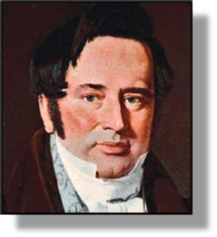 xxxxxIt was at this time that the fairytale play based on the legend of Aladdin was produced by the Danish poet and playwright Adam Gottlob Oehlenschlager (1779-
xxxxxIt was at this time that the fairytale play based on the legend of Aladdin was produced by the Danish poet and playwright Adam Gottlob Oehlenschlager (1779-
xxxxxHis plays are mostly based on Nordic history or mythology, and include three historical tragedies Earl Hakon the Great, the famous national hero, published in 1807, Baldur the Good of 1808 and Axel and Valborg, completed in 1809. His Nordic verse cycles Helge appeared in 1814, and his huge epic poem Gods of the North, five years later. Mention must also be made of his tragedy Correggio, based on the turbulent life of the 16th century Italian painter.
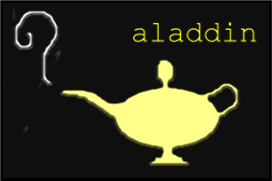
xxxxxOnce established as a national poet, he spent four years travelling around Europe, and it was then that he met leaders of the romantic movement, including Goethe, and wrote his most famous tragedies. Soon after his return in 1809, he was appointed professor of aesthetics at Copenhagen University. His historical works were immensely popular at the time, but today Oehlenschlager is mostly remembered for his lyric poetry.
xxxxxIncidentally, in 1820 Oehlenschlager wrote the words for the Danish national anthem: “There is a lovely land”.
xxxxxYet another story teller at this time was the German dramatist and poet Heinrich von Kleist (1777-
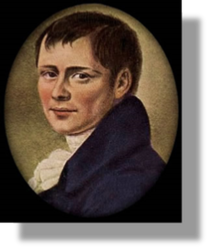 xxxxxYet another story teller at this time was the German dramatist and poet Heinrich von Kleist (1777-
xxxxxYet another story teller at this time was the German dramatist and poet Heinrich von Kleist (1777-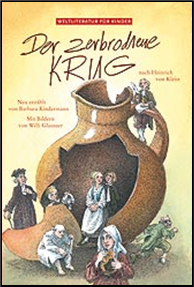 the Amazon tragedy Penthesilea (1808) -
the Amazon tragedy Penthesilea (1808) -
xxxxxKleist’s novels and plays, many with grim, emotional themes, were not popular in their day. and this was a great disappointment to him. Then in 1811 his newspaper Berliner Abendblatter, seen as a vehicle for German nationalism, was suppressed by the government. Deprived of his livelihood, and deeply depressed by the continuing occupation of his country, he took his own life in a suicide pact, shooting himself and a woman acquaintance who was incurably ill. It was a dramatic ending to what was a troubled and largely unfulfilled life. It was to be some years before his worth as a romantic poet and dramatist gained the recognition it deserved.


